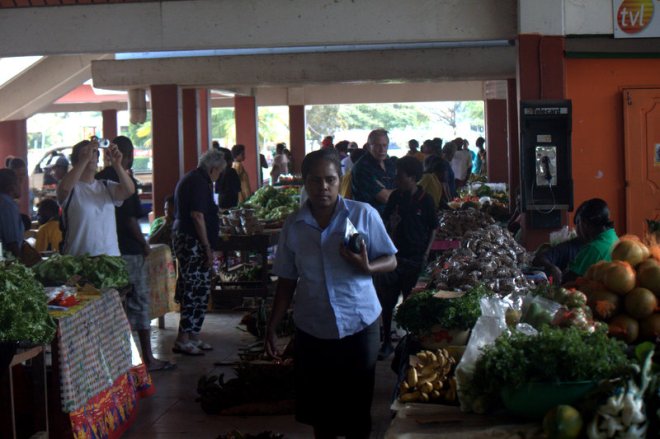We have made the turn. After a whirlwind visit to the lovely city of Melbourne, we flew north Brisbane and, for the first time since leaving Boston, turned east. With this leg we were also headed into completely unknown territory. Tonga was an experience, to be sure, and much of French Polynesia was new to us, but (with the exception of Australia) it has all been Polynesian and reasonably familiar by comparison with the place we were now headed to on…
Vanuatu is at the eastern edge of the western Pacific, west of Fiji and Tonga and therefore outside the Polynesian triangle. It has a fascinating, complex culture and is a favorite tourist destination for Australians, but the reason we were there is that it is also has one of the most important archaeological sites in the Pacific.
I have been lucky more than once on this trip and the Vanuatu leg is just another case in point. Matthew Spriggs and Stuart Bedford of ANU have been working a site at Teouma since 2004 which has yielded some of the most spectacular finds of Lapita pottery anywhere in the Pacific. They are now coming to the end of their work there and had expected to be finished by the time we reached nearby Port Vila. This was a great disappointment to me because I was really dying to see an archaeological dig, and particularly this archaeological dig, but there was just no way I could get us there in time. Then, quite unexpectedly, they had to suspend work for a week and that pushed their departure forward so that I could just make it out there before site was bulldozed over.
It was a tremendous experience. Unfortunately for Seven, he had to stay back and mind the children, and I didn’t take any photos because I wasn’t sure I should. But it was absolutely phenomenal. While I was standing there they pulled a 6-inch piece of pottery out of the ground that — I was reliably informed — was 3000 years old!
Lapita, just fyi, is the name given to the ocean-going culture that is thought to have moved rapidly out of island southeast Asia and into the western Pacific some 3000 to 5000 years ago eventually reaching Tonga and Samoa. As such, they are understood to be directly ancestral to the people who colonized Polynesia proper. Lapita sites are identified by a particular type of pottery with a range of decorative styles that correlates pretty directly with age, the most elaborate being the oldest.
Fortunately, Seven and I did get a chance to go together to the National Museum of Vanuatu the next day.
There Stuart and a couple of the guys who work with him showed us a number of spectacular pots, both fragments and reconstructions, which were just being packed and shipped off to an exhibit in Paris — the first of its kind! Here is a picture Seven took of the example that is in the museum along with the accompanying text, which is also interesting for its several translations.

There are a vast number of languages spoken in Vanuatu (including a couple of Polynesian languages, one of which was spoken in a village near where we were staying, as we discovered on the bus ride out there). But the three official languages of the country are French, English, and Bislama, which is not that hard to decode when written but pretty darn hard to understand when spoken fast. Children apparently go to school in either French or English, but I could never figure out how people decide. Mostly people spoke English with us, even on the few occasions on which I spoke French to them :).
The people of Vanuatu are as varied as the linguistic scene suggests and I clearly have to do some more research to find out who they all are and what they speak and where they come from and all of that. But for now I’ll just leave you with a few random shots taken in and around Port Vila. Here are some musicians at the airport (this time it is a guitar):
And here are a couple of pictures from the market:
A couple of street scenes:

And a bunch of the workers going back to the mainland by boat:









One can sense your excitement in learning about what stories those ancient pots and artifacts have to tell. Glad you got to see the dig.
That’s a nice shot of the plane and the “Air Vanuatu” lettering!
We’ve been traveling around Maine, mostly off the grid but whenever there’s a signal, I go directly to the latest Sea People report which has considerably enhanced the scruffy Maine back woods experience. I’m particularly interested in the pots and patterns they are unearthing so if you can grab any printouts, I’ll help devour them on your return along with all the rest of the photos you’re taking. Seven is quite talented behind the lens!
btw, the latest Harvard Review is out and I think it’s one of the best ever which I probably say every year. Lots of enthusiasm from the audience! But never mind all that when you’re galavanting about in Vanuatu…
Also if you come across any cd’s of singing in some of the rare languages, I’d love it if you could grab one or two for my video soundtrack. Clearly I’m begging you to go to work for me here!
Keep those posts coming and feel free to ignore my requests. xxx